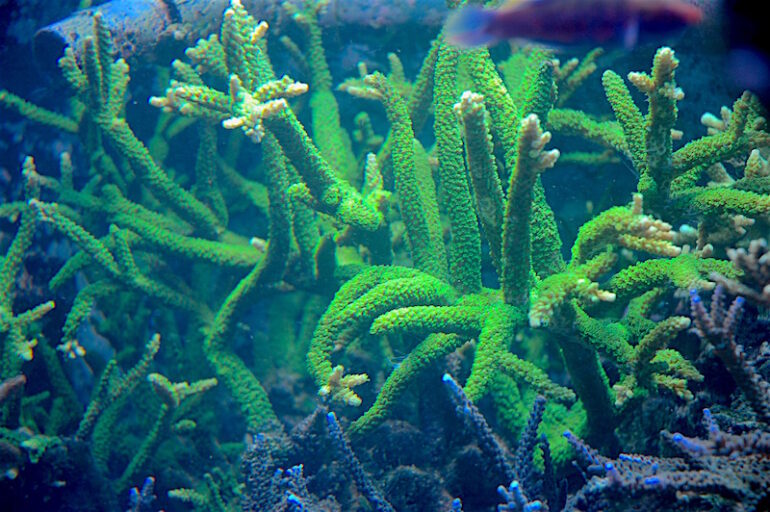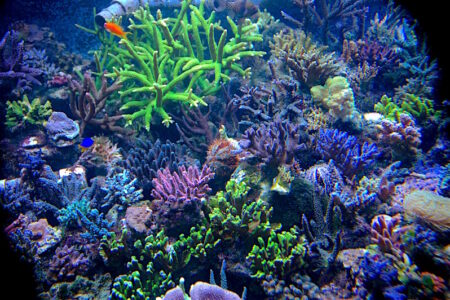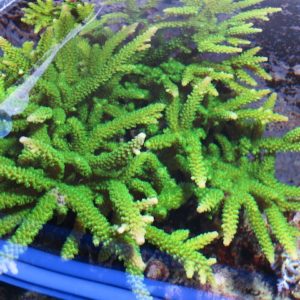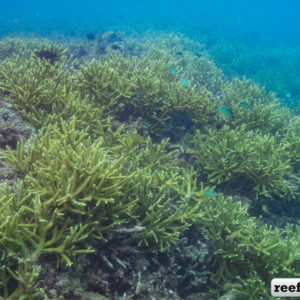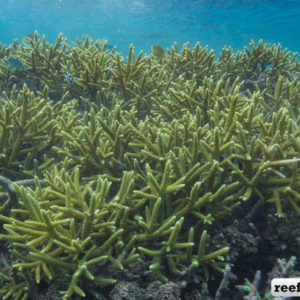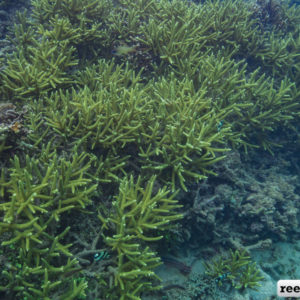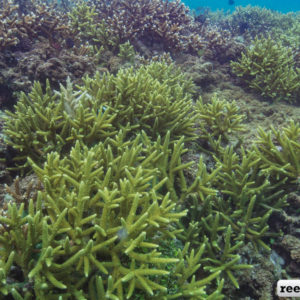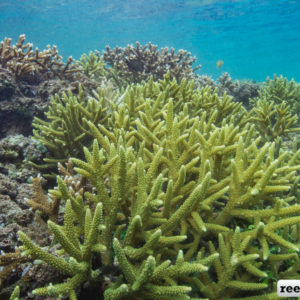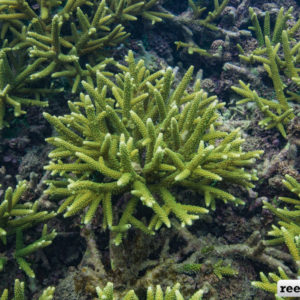Bali Green Slimer
The Bali Green Slimer (Acropora yongei) is a classic aquarium coral which has been in the hobby for more than 20 years. No fancy colors, or psychedelic tentacles. This classic Acropora is as green as they come, but there is much to learn from this prolific species.
Back in the 90’s when people started keeping Acropora’s in aquariums, hobbyists were “just happy to keep them alive let alone growing”. Mike Paletta shared his experience with the classic Bali Green Slimer in his article Some Of My Favorite SPS Corals.
When wild colonies of bright green Acropora yongei first entered the trade and aquarist started seeing fast, robust growth, word spread quickly. Soon branches of green Acropora were making their way around the country and you could find a piece of this distinctive coral is nearly every reef tank.
While definitely not a flashy coral by today’s standards, back in the day, the Bali Green Slimer was a big deal. The neon green was one of the most colorful corals available and became a showpiece in early reef tanks.
Reading through Mike’s article and his first encounters with the Bali Green Slimer, he writes, “Many of us still recall the comments of dive masters at the time, not to touch any coral as it took decades for them to grow even an inch. So for many of us when we started keeping Acroporas we took this to heart and did not expect to see much growth let alone rapid growth.”
“So when we started keeping this coral successfully we were shocked when once it started growing it did so robustly. So much so that for many of us it was one of the first corals that we propagated and did so on a large scale.”
In The Wild
In the wild Acropora yongei is a dominant species, living in shallow wave-swept, sundrenched habitats down to darker, deeper, waters below 65 feet or 20 m. Most Acropora species you find in the wild are in the upper reaches, where sunlight is abundant, and steady flow replenishes the reef.
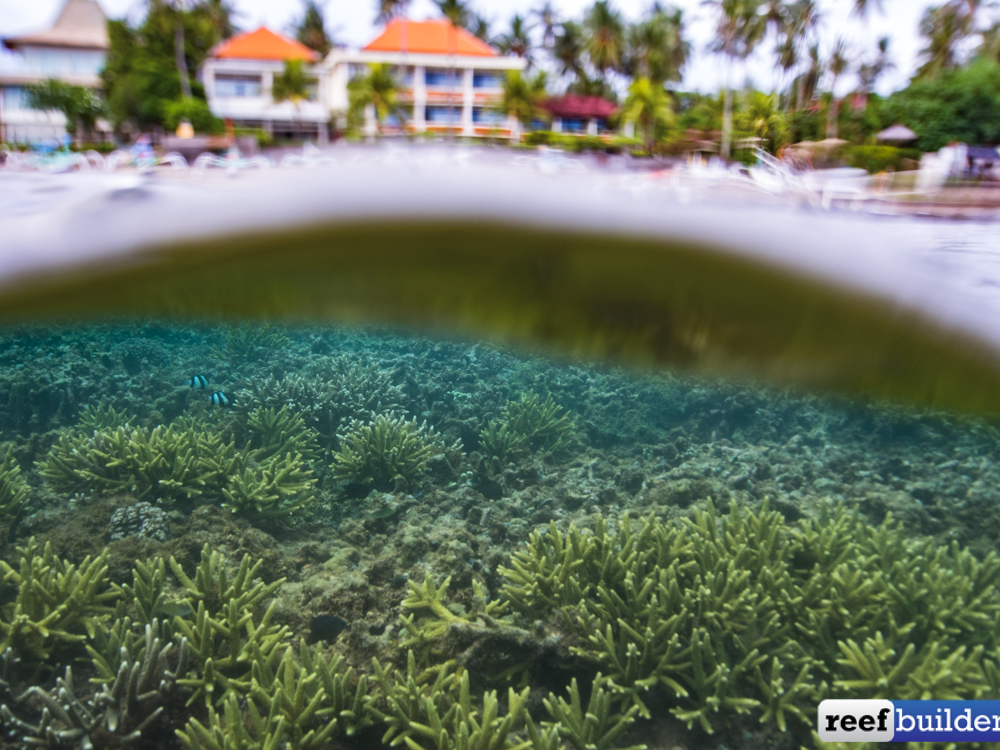
Because of this incredible range of habitats, Acropora yongei forms large impressive stands, take for example this colony of Blue Acropora yongei, documented by Bruce Carlson in the Solomon Islands.
Not only does its tough genetics make it a dominant reef-building species, but it creates a resilient coral that can tolerate fragmentation and transportation. This also means it can adjust to just about any lights and flow conditions, perfect for novice aquarist’s just learning the keep Acropora corals.
The name, however, implies a slimy secret. While the Bali Green Slimer can tolerate fragmentation, it will quickly produce a slimy mucus when disturbed. If you are planning to send a frag to your friend, you will want to wait a few days for the slime to settle down before packing it up!
We shot these pictures of wild Green Slimer while diving in Bali with Vincent Chalias. He pointed out these colonies as we snorkeled near shore, and encouraged me to learn more about this coral which lay the foundation for modern-day reef keeping.
Back To The Basics
Aquarists are missing that back to basics joy of just being able to keep a coral alive, let alone growing them, as Mike puts it, even in their most basics green form. Twenty years ago growing this species was all the rage, now new aquarist just entering the hobby might not even know it exists.
With the availability of coral frags, easy access to advanced husbandry equipment, and a wealth of knowledge at your fingertips, it’s easier than ever to grow corals in your home. And with seemingly every aquarist fragging their own corals, affordable overnight shipping, trippy blue lights, and orange tinted glasses, if a coral doesn’t melt your face off with at least three colors, it will barely turn heads let alone be propagated across the country in every reef tank in existence.
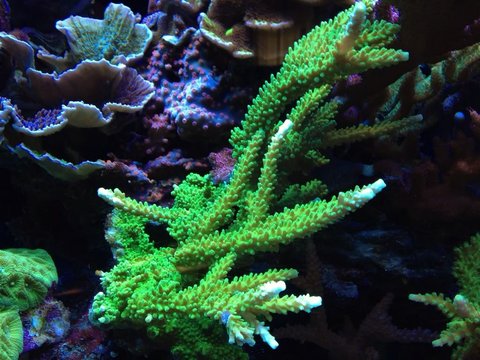
Hopefully, this article sparks an interest for this deserving coral, not only as a great beginner SPS but also for its history and importance to the aquarium hobby. Going back to the basics and just enjoying the process of growing big healthy corals is a rewarding experience that can help us foster a deeper respect for the animals we are keeping.
How many aquarists do you know that can say they’ve been keeping a coral alive for more than 20 years, or at least keeping the same corals alive since setting up their system? This is a goal all aquarist should strive to achieve.
To keep your Slimer happy place it in medium to high light with medium to high flow.


